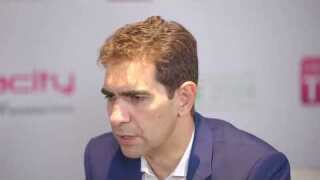Data will have to move to the edge of the network and be distributed around the world, says Equinix CEO Steve Smith. That will reduce the distance it has to travel, cutting latency and increasing response speed.
Smith was speaking at an innovation day held in London, when the company celebrated its 18th birthday in the company of customers, analysts and the media to discuss developments in the industry. He said that Equinix has a base of roughly 9,500 customers – both cloud and network providers – and the company has its vision clearly set on digital disruption in the form of mobile cloud enabled technology.
According to Smith, 75-80% of data globally sits on companies’ premises, but “more of this will move off premise and take advantage of the cloud”.
He identified seven key areas where disruption is most likely to occur: software-defined networks, subsea cables, manufacturing, healthcare, retail, professional services and insurance.
The growing need for businesses to expand their services and provide faster and reliable connectivity is one of the biggest challenges facing the industry today, he said, highlighting three key ways in which business will meet this demand: “speed, informality and adaptability”.
His views were echoed in a panel discussion on digital infrastructure featuring Steve Haines, group managing director at BT, Russell Poole, managing director of Equinix, and Julian David, CEO of TechUK.
Legislation
When asked about how technology and the capacity needs of customers are only barely met, the panel turned its focus on government responsibilities. Poole said: “Consistency within politics around legislation, development of our infrastructure, and development of skills” are still lagging.
Haines said: “Funding into the industry keeps it competitive.” David added: “Take away some of the barriers to competition. Have we the right policy to enable innovation? They [government] treat investment in infrastructure the same way as putting a conservatory on your house.”
Security was a key discussion point at the conference. There was much talk of security becoming increasingly software-based and getting those capabilities into the cloud and data centres globally.
Tim Rawlins, director and senior advisor of the NCC Group led the discussion on transport security in what is becoming an increasingly interconnected world.
He asked: “What is your attack surface as we become more interconnected?” In other words, can the various inter-connected wireless devices in your car be used to hack your system? What precautions are being taken to safeguard them?
Rawlins responded to a question by saying that hundreds if not thousands of transport systems are subject to attempted hackings every week. But he offered relatively simple solutions: design security in, do not refit it in retrospect, he said. Cyber security standards need to be developed with expert input in mind and transport technology needs to be independently assessed to ensure vulnerabilities haven’t been built in.
Michael Beaven, director of building services and environmental engineering at design and engineering company Arup, spoke on advances in innovative buildings. “People are interacting with the building”, he said, not merely existing inside of it and “technology is enabling people to be far more interactive in the workspace”.
Through machine learning and predictive control, the building itself can learn to create a better environment for its users. A good example is the IoT desk, a project that Arup is developing, which provides a completely personalised workplace experience.
The desk operates automated light sensors, and adjusts air quality and thermal comfort, learning how to create the best working environment. The future is in intelligent systems, smart surfaces and interactive working environments, all while offering feedback to enable the building to collect data and learn.
As the world moves increasingly faster, so too must technology. While some have adapted to this new way of thinking, many choose to hold on to the old ways of doing things. Some restrictions are as a result of government and technological limitations, but ultimately the ability of businesses to remain agile and embrace change appear to be the deciding factor in its continued success.
According to Smith, it’s about “moving decisions to communications”. We must “learn fast and fail fast”, he said.





